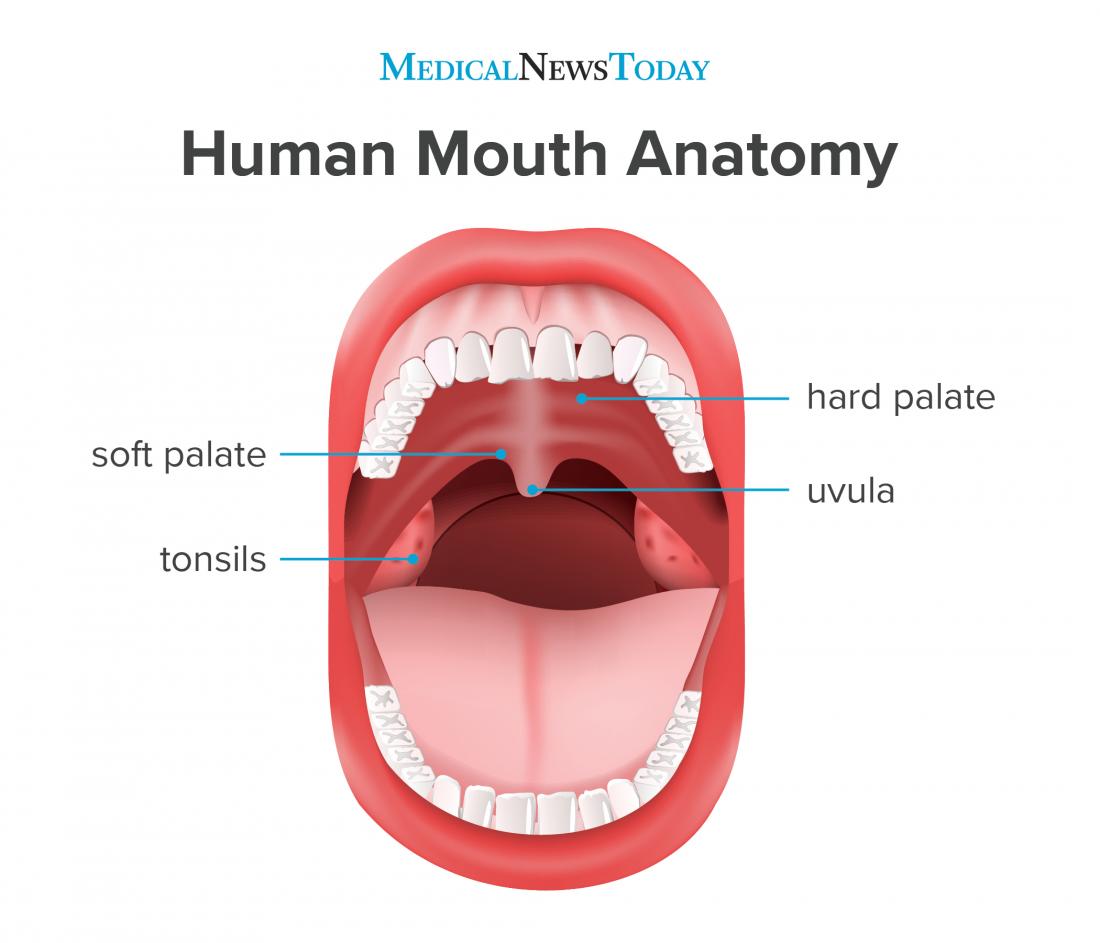The soft palate is the muscular part at the back of the roof of the mouth. It sits behind the hard palate, which is the bony part. The palates play important roles in swallowing, breathing, and speech.
In this article, we look at the anatomy and function of the soft palate. We also discuss what happens when there is an abnormality in the soft palate.

The hard and soft palates make up the roof of the mouth. The soft palate sits at the back of the mouth, behind the hard palate, which holds the teeth and gums.
The soft palate does not contain any bone but is a fleshy area that ends in the uvula. The uvula is the fleshy projection that hangs down from the soft palate and is visible when a person opens their mouth. The function of the uvula is to block the nasal cavity when a person is eating or drinking.
The soft palate comprises muscle and tissue, which make it mobile and flexible. When a person is swallowing or sucking, the soft palate completely separates the mouth from the throat, which helps keep food out of the respiratory tract.
The soft palate is also known as the muscular palate or the velum.
Together, the hard and soft palates form the roof of the mouth. Muscles and tissues make up the soft palate at the back of the roof of the mouth.
The hard palate sits at the front of the roof of the mouth and contains the palatine bone. The hard palate makes up two-thirds of the palate. It provides structure in the mouth and allows space for the tongue to move around.

The soft palate is important for the structure of the mouth and several key functions:
Speech
Speech is a highly complex process that involves the tongue, lips, and palate. These structures produce speech by directing airflow through the mouth to create certain sounds that form words.
If a person has a cleft palate or another soft palate disorder, air can escape through the nose and affect the speech. The speech may sound nasal or weak, or a person might miss some sounds.
Breathing
The soft palate separates the mouth and nose, acting as a barrier between the digestive and respiratory tracts. This function allows a person to breathe and eat at the same time. However, people are unable to swallow and breathe simultaneously.
Swallowing
When people swallow, they are moving food or liquid from the mouth down a tube called the esophagus to reach the stomach. During swallowing,
When a person swallows food or liquid, the soft palate rises to seal the opening of the airways to prevent pressure from escaping through the nose.
In some conditions that affect the palate, a person may experience difficulties with speaking, hearing, swallowing, and breathing. Below, we discuss various problems that can affect the soft palate.
Cleft lip and cleft palate
Among the most common congenital abnormalities that occur in babies are cleft lip and cleft palate. Often, people will have both. Cleft lip occurs if the tissue that forms the lip does not join between the
Some babies may have only part of the palate open, whereas other babies may have an opening across the whole palate.
A cleft palate can cause issues with speech and swallowing because the palate is unable to separate the respiratory tract from the digestive tract. Some babies with a cleft palate may have more frequent ear infections, hearing problems, or dental issues.
Surgeons can operate on the cleft lip and palate, and they usually do so before the baby’s first birthday. However, it is likely that additional operations will be necessary to repair the cleft lip and palate completely.
Doctors recommend surgery to aid breathing, speech, language, and hearing. Sometimes, children with a cleft lip and palate need special dental care when they are older.
Soft palate tumor
In some cases, people may develop a
Injury
People can injure their palate with hot food. A
Like a burn on the skin, these ulcers could become infected, so the healthcare professionals prescribed a 0.12% chlorhexidine disinfectant mouthwash. To allow the injury to heal, they also advised the individual to avoid smoking, drinking alcohol, and consuming very hot or acidic foods or drinks.
People with soft palate pain may find that rinsing the mouth with cold water can help ease discomfort. It is also important to be careful when brushing the teeth to avoid further injury to the palate.
Depending on the injury, doctors may also prescribe antibiotics if there is a risk of infection and recommend nonsteroidal anti-inflammatory drugs (NSAIDs) for pain and inflammation.
The soft palate and hard palate form the roof of the mouth. The soft palate is at the back of the roof, and the hard palate is the bony part of the roof closer to the teeth. The main functions of the soft palate are to aid speech, swallowing, and breathing.
Cleft lip and cleft palate are common congenital abnormalities. Doctors can repair the lip and palate early in life, and additional operations can help babies with swallowing and speech.
